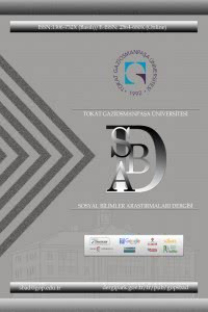Siegfried Sassoon & Savaş Şiiri
Bu çalışmanın amacı, Birinci Dünya Şavaşı İngiliz şairi olarak bilinen Siegfried Sassoon’ un üç şavaş şiirinin tartışmasından yola çıkarak, onun savaş şiiri özelliklerini ve savaşın acı yönünü ortaya koyabilmektir. Savaş temasının modernist şiirde işlenmesi, şiire sahici bir yaklaşım kazandırmakla birlikte, savaşın gerçek yüzünü okura ve topluma yansıtmaktadır. Bu bağlamda, bu çalışma için Siegfred Sassoon’un üç savaş şiiri tematik yaklaşım aracılığıyla incelenmektedir. İlk olarak, Sassoon’un bir siper şiiri olan “The Rear Guard” (Arka Muhafız), onun akabinde dönemin askeri yönetimi sorumlu tutan “The General” (General) ve son olarak da dönemin kadın tutumunu eleştiren “Glory of Women” (Kadın Büyüsü) şiirleri bu çalışmada Sassoon’un savaş şiirine örnekler olarak ele alınmaktadır. Sassoon bu üç şiirininde sırasıyla yeteneksiz askeri yetkilileri, din adamlarını ve politikacıları eleştirmekte ve savaşı boşu boşuna uzattıkları için onları suçlamaktadır. Sonuç olarak, Siegfred Sassoon savaş şiirine kendi özgeçmiş tecrübelerinin yanı sıra gerçekci ve ironik bir yaklaşım kazandırmıştır
Anahtar Kelimeler:
Siegfried Sassoon, Savaş Şiiri, Arka Muhafız, General, Kadın Büyüsü, Birinci Dünya Savaşı, İngiliz Savaş Şairleri, Savaşın Anlamsızlığı
Siegfried Sassoon & War Poetry
The aim of this paper is to delineate the general characteristics of Siegfred Sassoon’s war poetry and the grim realities of the war through discussing his three war poems. The study of war theme in modernist poetry brings a realistic approach to poetry and reflects the real face of the war to the reader and society. For this respect in this paper, three of Siegfred Sassoon’s war poems are studied through thematic approach. First of all, Sassoon’s trench poem “The Rear Guard” and secondly “The General”, his accusatory poem towards the military officials and lastly “Glory of Women”, his critical poem towards women is taken as exemplifications of his war poetry. In his three respective poems, Sassoon holds incompetent military authorities, religious people and politicians responsible for the cause of the war and finds them guilty since they prolong the war for the futility. As a result, Siegfred Sasoon brings not only his autobiographical experiences but a realist and ironic approach to war poetry as well
Keywords:
Siegfried Sassoon, War Poetry, The Rear Guard, The General, The Glory of Women, The First World War, The British War Poets, Futility of the War,
___
- Abrams, M. H., & Greenblatt, S. (2006). The Norton Anthology of English Literature: Vol. 2. New York: Norton.
- Bloom, H. (2003). Poets of World War I: Rupert Brooke & Siegfried Sassoon. Philadelphia: Chelsea House.
- Brearton, F. (2007). A War of Friendship: Robert Graves and Siegfried Sassoon. In Tim Kendall (Ed.), The Oxford Handbook of British and Irish War Poetry (pp. 208-226). Oxford: Oxford University Press.
- Campbell, P. (1999). Siegfried Sassoon: A Study of the War Poetry. Jefferson, N.C: McFarland.
- Corcoran, N. (2007). Wilfred Owen and the Poetry of War. In Neil Corcoran (Ed.), The Cambridge Companion to Twentieth-Century English Poetry (pp. 87-101). Cambridge: Cambridge University Press.
- Hemmings, R. (2008). Modern Nostalgia: Sigfried Sassoon, Trauma and the Second World War. Edinburgh: Edinburgh University Press.
- Lucas, J. (1986). Modern English Poetry - From Hardy to Hughes: A Critical Survey. Totowa, N.J: Barnes & Noble.
- Persoon, J.; Watson, R. R., & Facts on File, Inc. (2009). The Facts on File Companion to British Poetry, 1900 to the Present. New York: Facts On File.
- Roberts, N. (2001). A Companion to Twentieth-Century Poetry. Oxford:Blackwell Publishers.
- Williams, J. (1987). Twentieth-Century British Poetry: A Critical Introduction. London: Edward Arnold.
- http://www.wwnorton.com/college/english/nael/20century/topic_1_05/ssassoon.htm (Accessed 10th January 2013)
- ISSN: 1306-732X
- Yayın Aralığı: Yılda 2 Sayı
- Başlangıç: 2006
- Yayıncı: Gaziosmanpaşa Üniversitesi Sosyal Bilimler Enstitüsü
Sayıdaki Diğer Makaleler
Türkçede Yardımcı Fiil-Ek Fiil Meselesi ve Bir Terim Önerisi
Siegfried Sassoon & Savaş Şiiri
Yediçınar Yaylası’ndaki Kahramanlara Yönelik Psikolojik Bir Çözümleme Denemesi
Ayetlerde Çelişki Bulunduğu Vehmini Gidermede Kullanılan Yöntemler ve Bunların Değerlendirilmesi
Cumhuriyet Üniversitesi Bilgisayar Ağının Modellenmesi ve Uzaktan Eğitim için Performans Ölçümü
Süreç Felsefesinin Tanrı Anlayışının Mehmet Akif Ersoy’un Tanrı Anlayışı ile Karşılaştırılmas
Şebeke Analizinde Cpm Tekniği ve Bir Uygulama
OECD Ülkeleri İçin Genişbant Abone Sayısını Etkileyen Faktörlerin Çoklu Regresyon Modeli İle Analizi
Bilge ÇUBUKCUOĞLU, Taner ERSÖZ, Muharrem DÜĞENCİ, Turgut ÖZSEVEN
